 |
Photo
1 HT Hive 3 |
|
The (c)
Copyright 2001 Ian Rumsey Click on thumbnails for full size images |
The Development of the GM hive
At the end of 1999 it seemed
reasonable to conclude the 'HT' experiment and consider ways this method of
mite control could be introduced into modern beekeeping practice.
There seemed to be three 'next steps' that could run in parallel.
1.Fit supers on HT hives 1 and 3 and observe results.
2.Make two hives as per patent specification and observe results.
3.Continue monitoring HT
hives 6 and 12 being respectively very weak and very strong.
Experiment No 1
At the beginning of May, HT hive 1 had its roof removed and replaced with a sheet of 3 ply with a retangular hole in it 6" x 4" covered with queen excluder. Upon this was placed a hollow tree type section with a 1" entrance hole, the original roof now being replaced on top.
The bees did not think much of this and sealed up the queen excluder by the end of June. Also in early May, HT hive 3 was fitted with a 'National' super as shown in photo No 1. Again the bees did not like this either. The entrance was sealed almost immediately and by degrees the queen excluder was also filled up, no mean feat as it was 12" square.
From this I concluded that bees in tall, narrow hives will not store honey above the brood nest to any depth, and this is why conventional hives require to be short and fat.
The weekly varroa drop was continued for these hives as shown below.
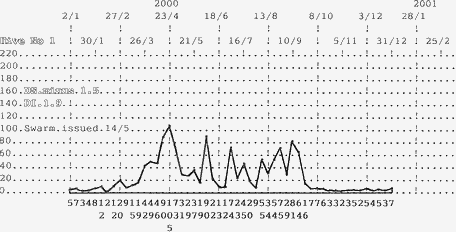

Experiment No 2
The patent specification was a shot in the dark. You can hardly patent a space at the bottom of the hive or indeed the position of the entrance, nor can you patent anything that is obvious.
This only left the orientation of the frames in the hive.
The varroa limiting factor comes in two ways, the grooming of the mite outside the cell, and the uncapping of unhealthy cells.
I felt that the first line of defence was the grooming, and if sufficient, the second line of defence would not need to come into play.
If you therefore contained the brood nest even further, within a 9"square, instead of the 11" square of the HT hive, would the grooming alone be capable of containing the mite numbers.
I made two of these hives Nos 10 and 11 as shown in photo 2.
A swarm was introduced into each hive and the varroa drop recorded as shown below.

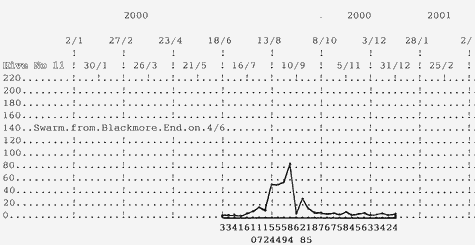
From the debris on the floor, evidence of uncapping was present, so in this case both lines of defence were operating.
However the
varroa limiting factor was still present and the total number of mites counted
would appear lower than in hives 1.3,12 during 1999,which may be due to the
narrowness of the hive body.
Experiment No3
Hive No 6 never really got off the ground, the depth of comb never exceeded 12" and was an inverted U shape with 1" columns down the walls of the hive. The number of bees never increased April/May/June, and the comb was static.
The bees themselves were never busy, they got up late, went to bed early, and were always thinking about it.
The colony eventually succumbed in September to wasps which in this area will invade a hive with only a single 1" diameter hole as an entrance and the bees physically have to block this with their bodies, and even then the wasps will force their way in. Hive 6 stood no chance.
The varroa drop count for this hive is shown below and follows the theory, small colony few varroa
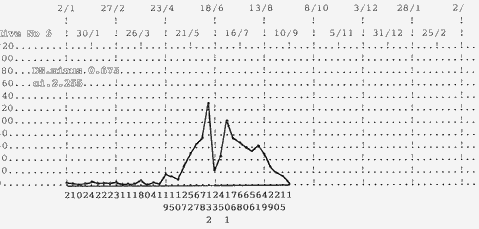
Hive 12 were completely different, they soon made 32" of comb in 2000, got up early, worked all day, bred many bees and many varroa.
They were visually more 'yellow' than any other colony, and this was reflected in their morphometric measurements with discoidal shift minus 0.475 and cubital index 2.4.
They swarmed three times and the varroa drop count responded accordingly as show below
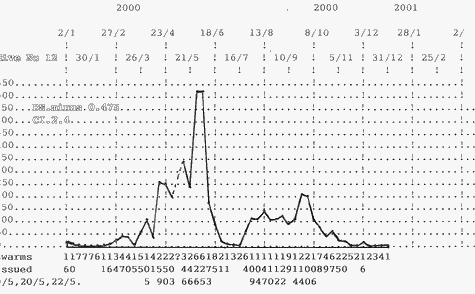
The Geometrically Modified Hive
With all the information collected over three years, it appeared reasonable to reappraise the situation.
We know that bees survive in hives as small as 9"x 9" and 18" deep, with an entrance in the middle, a void beneath the comb, and without any interference by man.
We also know that to incorporate this into current beekeeping practice, today's equipment must be utilized, with full inspection available at all times.
As we are unable to obtain a honey crop above a tall narrow brood nest, and the space beneath is required for groomed varroa, the only other space available is at the sides.
By making the walls of our 9"x 9"x 18" hive out of queen excluder, and positioning this inside a conventional hive body, all requirements may be met.
Photographs A,B,C & D. refer.
Photo A..
Photo B.
| Portrays
the frame mounted on one cage, with the second cage on top. This is the brood chamber with access through the centre hole if you are a queen or a drone. |
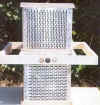 |
Photo C.
| Shows this arrangement placed within the brood chamber of a 'National' hive with another cage placed on top with a lid. | 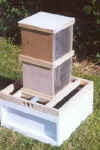 |
Photo D.
| Barely,
barely, quite contrary, That's how varroa grow, They lose their lives,in 'GM' hives, All in a row. |